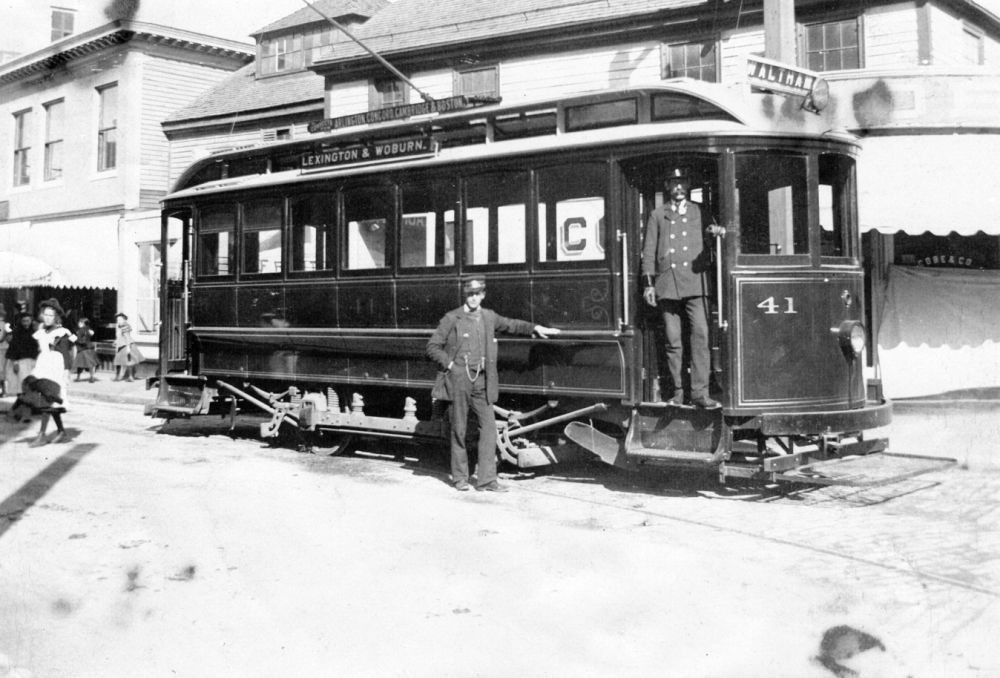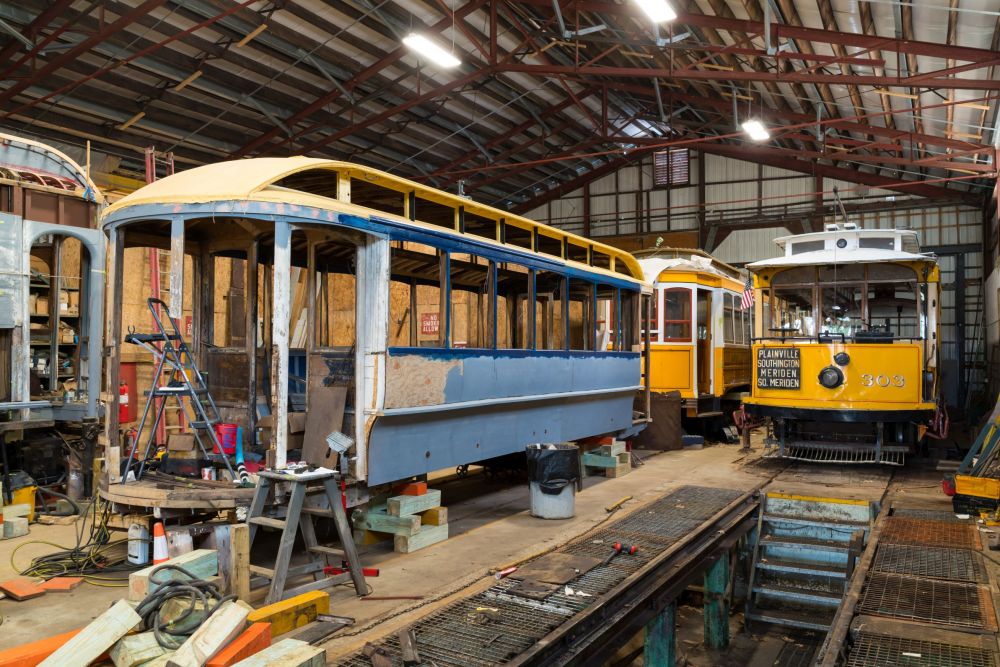
At Lexington & Main Sts. on 10/07/1901 Courtesy of Waltham Historical Soc.
- Builder
- John Stephenson Car Co.
- Secondary Use
- Diner and later gift shop
- Type
- City and Suburban Streetcars
- Year
- 1901
- Retired from Service
- 1930
- Acquired by the Museum
- 1962
- Note
- As of September 2018, No. 41 is in the restoration shop with restoration of the body well underway.
- Fund
- 754
- Sponsor/Manager
- Karen Dooks and Edward Dooks
Lexington & Boston St. Ry. 41
From Massachusetts
History
The Lexington & Boston opened a local streetcar route between Lexington and Waltham, MA in 1901, with four small cars bearing the numbers 37 through 43, odd numbers only. John Stephenson Car Co. built these cars prior to Brill’s absorption of the Stephenson Company. The Lexington & Boston cars had a single truck and a railroad roof – an unusual combination. The L&B painted its cars dark blue with gold trim. A photo shows L&B No. 41 signed for the Lexington and Woburn route. Sometime between 1905 and 1912, the L&B installed steel panels on No. 41’s upper side panels.
The Middlesex & Boston Street Railway was formed in 1899 to acquire the small street railways in the Boston suburbs. In 1912, the M&B acquired the Lexington & Boston. The M&B became the third largest street railway in Massachusetts. It operated lines from Lexington to Lowell and to connections with the Boston Elevated streetcar lines near the Boston city boundary. The M&B also served Norumbega Park in West Newton. The M&B assigned No. 41 to its Natick Division with routes to Wellesley and Needham, MA. The M&B painted No. 41 in its maroon and cream colors. By 1921, the M&B placed No. 41 in storage.
In 1927, the M&B sold No. 41 to Ray McGowan, who converted it into a diner in Natick, MA known as “Ray’s Lunch.” McGowan purchased No. 41 without its truck and electrical gear. In 1937, McGowan enclosed No. 41 in a larger building. Customers at Ray’s Lunch included Boston Braves baseball players. McGowan banned mobster James “Whitey” Bolger after Bolger insulted McGowan’s wife at the diner. After World War II, the car became a gift store. When further development of the property threatened No. 41, C. David Perry purchased the car and then donated it to Seashore in 1962. Seashore stored No. 41 outdoors until moving it into the Fairview barn in 1978. Douglas Carrier, a museum member, began a program to raise money for No. 41’s restoration in the late 1990’s. The McGowan family has supported the museum’s restoration of No. 41, and Seashore will honor the McGowan family with a plaque on the restored car. Seashore has accomplished significant restoration work since moving No. 41 into the restoration shop in 2010. The museum is restoring No. 41 to its 1912 appearance prior to its painting in the M&B colors.
No. 41 came to Seashore without trucks. A builder’s photo of twin No. 37 shows that Stephenson built the cars with a Bemis 203 truck. Seashore located one of these trucks from a Norway & Paris Street Railway car. The truck had been left in a swamp after that line was abandoned. It is being extensively rebuilt and equipped with some motors from Japan so that it may be placed under No. 41. L&B No. 41 is the only surviving trolley from the L&B/M&B systems and is believed to be the oldest extant car built by the John Stephenson firm. [See also: Curatorial Report No. 1 in the restoration shop files, Curatorial Reports Nos. 2, 3 and 4 on the museum website, and various Dispatch articles including “New Life for M&B Car 41” in September 1998 Dispatch and “Middlesex & Boston #41 Arrives at Town House” in March 2011 Dispatch.]
Technical Information
- Seats: 26
- Brakes: Hand
- Compressor: None
Trucks
- Number: 1
- Manufacturer: Be,is
Weight and Dimensions
- Length: 29’ 6.00"
- Weight: 12000 lbs.
Additional Images

Derek Carter on 07/06/19
© 1998 - 2025 New England Electric Railway Historical Society. All Rights Reserved.